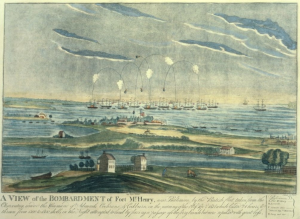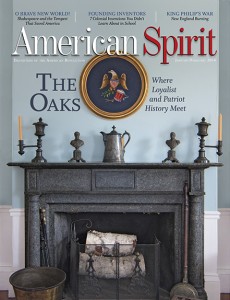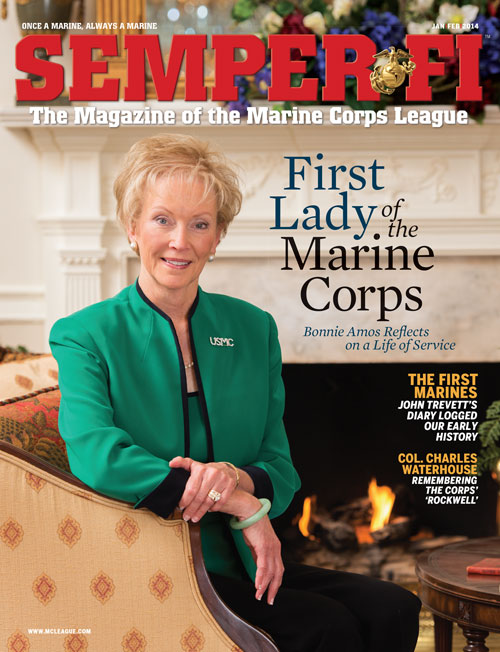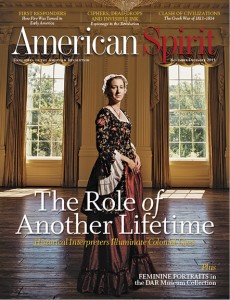



Maybe we’re biased because we work with the Marine Corps League on its magazine, Semper Fi, but for our money nobody plays “The Star-Spangled Banner” better than a Marine Corps band. Though there are a number of bands at Marine Corps installations, “The President’s Own” is the original, tracing its roots to 1798 when it was founded by an of Congress. Dubbed “The President’s Own” by Thomas Jefferson, The Marine Band is America’s oldest continuously active professional musical organization, and is celebrated for its White House performances and hundreds of annual public concerts.
It was The Marine Band that first played the tune of “The Star-Spangled Banner” at the White House during a reception given by President Thomas Jefferson on July 4, 1806. At that time the tune was called “To Anacreon in Heaven,” and was the official drinking and feasting song of an amateur musicians’ club in London called the Anacreontic Society. A guest at the reception later recalled “an exquisite band of music [that] played at intervals martial, patriotic, and enlivening airs, which reverberated through the spacious dome.”
Some eight years later, Francis Scott Key wrote new words for the tune after witnessing Fort McHenry, Maryland, withstand a bombardment by the British Navy during the War of 1812. The new song became a popular, if challenging, patriotic song in the 19th century, though it was not made the national anthem until 1931.
We at Hammock join with you in celebrating our independence and thanking all the men and women who have laid their lives on the line to defend it since 1776. And we can’t think of a better way to kick off your celebration than by playing “The Star-Spangled Banner” as performed by “The President’s Own.”:
We’ll hear “The Star-Spangled Banner” played a number of times over the next few days, and no doubt, we’ll think of fireworks when we hear “the rockets’ red glare/the bombs bursting in air.”
But, as we explain in the July/August issue of American Spirit, which Hammock publishes with the Daughters of the American Revolution , the rockets that Francis Scott Key immortalized weren’t playthings. They were a British system of military rocketry that largely failed to carry out its mission against Fort McHenry, the fort that defended Baltimore Harbor during the War of 1812.
, the rockets that Francis Scott Key immortalized weren’t playthings. They were a British system of military rocketry that largely failed to carry out its mission against Fort McHenry, the fort that defended Baltimore Harbor during the War of 1812.
Designed by the English inventor Sir William Congreve and modeled on rockets used against the British in India by Indian troops, the rockets that flew over Fort McHenry weighed about 32 pounds and had two major deficiencies—they were unreliable, inaccurate and also tended to explode prematurely.
The rockets fired on September 13, 1814, were launched from the British ship Erebus, and ultimately did little physical damage, though the screaming, wildly gyrating rockets terrified American defenders.
Congreve’s rockets consisted of an iron tube packed with propellant and a conical warhead, with three interchangeable payloads including incendiary devices, explosives and case shot—anti-personnel devices that exploded and sprayed iron balls in a lethal cloud. They ranged in size from 3 to about 32 pounds, and could be fired from ships as well as by troops on the ground.
 Hammock Inc.’s work for clients has earned six Apex Awards, including a coveted Grand Award, in the just-concluded competition.
Hammock Inc.’s work for clients has earned six Apex Awards, including a coveted Grand Award, in the just-concluded competition.
The Grand Award went to American Spirit, the bimonthly member magazine of the National Society Daughters of the American Revolution, which we have published for DAR since 2002, and which has taken a number of Grand Awards.
The competition’s judges lavished praise on the November-December 2013 issue of American Spirit, saying that, “This is a magazine that never fails to appeal. The design and layout are richly stunning, but the editorial well is the tour de force here. Features are thoroughly researched and presented in a lively and engaging manner. You find yourself reading each to the end, even when the topic is one you didn’t think would particularly interest you. Top drawer in every respect.”
Apex Awards of Excellence were accorded to:
 For four years, American Spirit* has dedicated its March/April issue to Women’s History Month. It’s a particularly enjoyable issue to write, edit and design in partnership with the Daughters of the American Revolution since it gives us a chance to find and promote little-known stories of fascinating women of early America.
For four years, American Spirit* has dedicated its March/April issue to Women’s History Month. It’s a particularly enjoyable issue to write, edit and design in partnership with the Daughters of the American Revolution since it gives us a chance to find and promote little-known stories of fascinating women of early America.
One of those women is a Cherokee “Beloved Woman” named Nan-ye-hi, an influential leader and peacekeeper during a time of great upheaval in the Cherokee Nation. Despite my living in Tennessee–her home and that of her ancestors–for the past 10 years, I had never even heard of Nan-ye-hi until the Nancy Ward DAR Chapter (named after her English name) suggested researching her life for this issue. It was a privilege to share that research with readers.
Our cover was designed to highlight Nan-ye-hi and two of the other diverse and distinguished women featured in this issue. Illustrator Antonio Rodrigues used organic shapes and earthy colors to illuminate Elizabeth Freeman, the former slave who helped abolish slavery in Massachusetts, St. Elizabeth Ann Seton, a pioneer in Catholic education who became the first U.S. citizen to be canonized, and Nan-ye-hi. The subtle background script that fleshes out the illustrations underscores one of American Spirit’s goals: to faithfully record these early American women’s remarkable stories and convey their importance to modern readers.
Another feature is excerpted from Nancy Rubin Stuart’s book, Defiant Brides: The Untold Story of Two Revolutionary-Era Women and the Radical Men They Married. Stuart details the moments that Lucy Flucker Knox and Peggy Shippen Arnold met their Revolutionary husbands Henry Knox and Benedict Arnold, and hints at ways the women’s initially parallel lives eventually diverged.
It’s Mardi Gras season, so it’s fitting that we travel to Louisiana for two stories: Our Historic Homes department visits Laura Plantation, a French Creole sugar plantation that was run by several strong-willed women in the 19th century, and Spirited Adventures checks in on Natchitoches, the oldest permanent settlement in the Louisiana Purchase.
*For more than a decade, Hammock has been honored to assist the National Society Daughters of the American Revolution in publishing their award-winning magazine. Anyone can subscribe here.
 Every issue of American Spirit* invites readers to learn more about a historic home–and its owners–particularly those with connections to the Colonial or Early American period. Gracing the January/February cover is The Oaks, a Worcester, Mass., home finished at the end of the Revolution by Judge Timothy Paine and later occupied by his son, Dr. William Paine. Both Paines were Tories, but, ironically, the home is now owned and preserved by the Colonel Timothy Bigelow DAR Chapter, named for the Revolutionary minuteman, prisoner of war and military commander.
Every issue of American Spirit* invites readers to learn more about a historic home–and its owners–particularly those with connections to the Colonial or Early American period. Gracing the January/February cover is The Oaks, a Worcester, Mass., home finished at the end of the Revolution by Judge Timothy Paine and later occupied by his son, Dr. William Paine. Both Paines were Tories, but, ironically, the home is now owned and preserved by the Colonel Timothy Bigelow DAR Chapter, named for the Revolutionary minuteman, prisoner of war and military commander.
Another feature honors the French-born Patriot Comte de Rochambeau. He forged an effective partnership with George Washington and played an integral role in the British defeat at the Siege of Yorktown.
We delve into law and order, early-American-style, for a feature on Virginia statesman George Wythe. We investigate the mysterious circumstances of this Patriot’s painful death, probably at the hands of his ne’er-do-well grandnephew.
 In the Januaru-February issue of Semper Fi, the magazine of the Marine Corps League, we are proud to present an exclusive, in-depth interview with Bonnie Amos, wife of the 35th USMC Commandant, General James F. Amos.
In the Januaru-February issue of Semper Fi, the magazine of the Marine Corps League, we are proud to present an exclusive, in-depth interview with Bonnie Amos, wife of the 35th USMC Commandant, General James F. Amos.
Over more than 40 years of marriage, Mrs. Amos has seen virtually every aspect of Marine life. This gracious and soft-spoken woman often dons a helmet and body armor to accompany her husband to the war zones to bring a touch of home to Marines at the point of the spear.
Her work with injured Marines helped bring about the standing up of the Wounded Warrior Regiment. Together, she and General Amos care about, watch over and work for the betterment of Marines and their families. Her story will inspire and move you.
Also in the January-February issue, we travel back to the Corps’ early days as recorded in the diary of Continental Marine John Trevett. Serving under our first Commandant, Capt. Samuel Nicholas, Trevett took part in the Corps’ very first amphibious operations.
 Population health was foremost on our minds as we prepared the Q4 issue of The Source, the magazine we help HealthTrust publish for healthcare supply chain professionals. Healthcare systems and physicians groups are developing new programs aimed at population health management, a systematic approach to addressing the preventive, high-risk and chronic care needs of patients, with a goal of minimizing costly interventions like emergency room visits, hospitalizations and readmissions. We interview Dr. David Nash, of the Jefferson School of Population Health in Philadelphia, on this healthcare paradigm shift. As the founding dean of the first designated school of population health in the country, Nash is considered one of the leading experts in the field.
Population health was foremost on our minds as we prepared the Q4 issue of The Source, the magazine we help HealthTrust publish for healthcare supply chain professionals. Healthcare systems and physicians groups are developing new programs aimed at population health management, a systematic approach to addressing the preventive, high-risk and chronic care needs of patients, with a goal of minimizing costly interventions like emergency room visits, hospitalizations and readmissions. We interview Dr. David Nash, of the Jefferson School of Population Health in Philadelphia, on this healthcare paradigm shift. As the founding dean of the first designated school of population health in the country, Nash is considered one of the leading experts in the field.

Though we’re not going to dress up in fancy ballgowns or tuxes with Stetsons and hand-tooled boots like the folks at the CMA awards this week here in Nashville, we at Hammock are celebrating with our clients over a clutch of MarCom awards for the work we are honored to collaborate with our clients in creating.
The MarCom Awards is an international creative competition for anyone involved in the concept, writing and design of print, visual, audio and web materials and programs. The program is administered by AMCP, the Association of Marketing & Communication Professionals. There were about 6,000 entries this year from individuals to media conglomerates and Fortune 50 companies.
Here’s what was in the envelopes:

American Spirit* visited the American Village, a history and civics education center in Montevallo, Ala., for our November/December 2013 cover story profiling historical interpreters. (This editor grew up less than a mile away from the American Village, and it’s her family’s favorite spot for Fourth of July fireworks and other patriotic events.) The American Village re-enactors and others spotlighted in our story exhibit an extraordinary commitment to historical detail. That commitment to authenticity is best expressed by this quote from Patricia Bridgman, who plays Abigail Adams at Adams National Historical Park in Quincy, Mass., and at the Abigail Adams birthplace in Weymouth, Mass.
“I sweep my bangs up into a pompadour, eschew makeup, lace myself into stays, don a bum roll [a support, such as a hoop or pillow, worn under a skirt], petticoats and gown, along with silk stockings and reproduction shoes, and I’m ready to go,” Ms. Bridgman says. “The one question all re-enactors get is, ‘Aren’t you hot in that?’ The 21st-century answer is, ‘Damn straight,’ but Abigail says, ‘I am well accustomed to it, madam.’”
 Every U.S. Marine has three birthdays—their first, the day they earned the Eagle, Globe and Anchor, and the birthday of their beloved Corps on 10 November. And the November/December 2013 issue of Semper Fi, the Magazine of the Marine Corps League, sends a birthday greeting to all Devil Dogs, with this cover photo of Lance Corporal Chesty XIV, the USMC’s official mascot.
Every U.S. Marine has three birthdays—their first, the day they earned the Eagle, Globe and Anchor, and the birthday of their beloved Corps on 10 November. And the November/December 2013 issue of Semper Fi, the Magazine of the Marine Corps League, sends a birthday greeting to all Devil Dogs, with this cover photo of Lance Corporal Chesty XIV, the USMC’s official mascot.
The issue also contains birthday greetings from General James F. Amos, the 35th Commandant of the Marine Corps.
Marines have always had a reputation of traveling fast and light, and in the 21st century, the Corps is working hard to reduce its needs for energy, water and resupply. In “Power Play,” contributor Otto Kreisher looks at ways Marines are increasingly using solar energy and local resources to remain in the field longer without resupply. It’s a life-saving as well as environmental concern, since supply lines can be cut, and lives are at risk convoying necessities like fuel and water to forward deployed Marines.